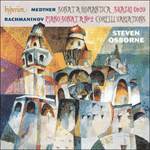One of Medtner’s projects that remained unrealized at the time of his death was to record the 'Sonata Romantica', Op 53 No 1. Composed in 1930 in Paris, and first performed by the composer in Glasgow the following year, this was the twelfth of his fourteen piano sonatas. Not only its title but also the expressive content of its four movements, played without a break, make it virtually a manifesto for Medtner’s art. Cast in B flat minor—a favourite key for Chopin, Tchaikovsky and Balakirev, as well as being adopted by Rachmaninov for his second sonata—the opening Romanza soon engulfs its lyrical impulse in troubled swirls of figuration (the score is peppered with agitato and tranquillo markings). Following the pattern of Chopin’s ‘Funeral March’ Sonata, the scherzo then goes another step flatwards, to E flat minor. Here the commonest marking is leggiero (lightly), offsetting the pesante opening and the tumultuoso climax. The Meditazione is no less exacting in its demands—espressivo ma semplice, legatissimo, sordamente (muted) as well as una corda all appear in the first bar. The main character of this slow movement is the gentle lilt imparted by dotted rhythmic figures, making it a close cousin to the second theme in the first movement of Rachmaninov’s second sonata. If Medtner’s finale at first seems rather less personal in its thematic invention, that is partly because its strategy will be to combine its own material with recalls of the previous movements, in an almost obsessive-compulsive tying together of threads.
from notes by David Fanning © 2014
Parmi les ambitions de Medtner restées à l’état de projet à l’heure de sa mort, il y avait l’enregistrement de sa «Sonata Romantica», op.53 no 1. Composée en 1930 à Paris, et créée par ses soins l’année suivante à Glasgow, cette œuvre était la douzième de ses quatorze sonates pour piano. Son titre et le contenu expressif de ses quatre mouvements, joués d’une traite, en font presque un manifeste de l’art medtnerien. Coulée en si bémol mineur—une tonalité chère à Chopin, Tchaïkovski et Balakirev, également élue par Rachmaninov pour sa Sonate nº 2—, la Romanza inaugurale plonge bientôt son impulsion lyrique dans des tourbillons de figurations agitées (la partition est criblée d’indications agitato et tranquillo). Sur le modèle de la «Sonate funèbre» de Chopin, le scherzo franchit encore un degré vers la bémolisation pour atteindre mi bémol mineur. L’indication la plus courante ici, leggiero (avec légèreté), compense le début pesante et l’apogée tumultuoso. La Meditazione est tout aussi exigeante: les indications espressivo ma semplice, legatissimo, sordamente (étouffé), mais aussi una corda figurent toutes à la première mesure. Le principal caractère de ce mouvement lent est le doux balancement transmis par les figures rythmiques pointées, ce qui en fait un proche cousin du second thème du premier mouvement de la Sonate nº 2 de Rachmaninov. Si le finale de Medtner peut sembler, de prime abord, d’une inventivité thématique moins personnelle, cela tient notamment à son choix stratégique de mêler son propre matériau à des rappels des mouvements précédents, avec une manière quasi obsessionnelle, compulsive de toronner les brins.
extrait des notes rédigées par David Fanning © 2014
Français: Hypérion
Ein Projekt Medtners, welches bis zu seinem Tod nicht realisiert wurde, war die Einspielung der „Sonata Romantica“, op. 53 Nr. 1. Diese zwölfte seiner insgesamt vierzehn Klaviersonaten entstand in Paris im Jahre 1930 und wurde erstmals von dem Komponisten selbst im folgenden Jahr in Glasgow aufgeführt. Nicht nur der Titel, sondern auch der expressive Inhalt der vier Sätze, die ohne Unterbrechung gespielt werden, weist diese Sonate sozusagen als Manifest für Medtners Kunst aus. Sie steht in b-Moll—eine bevorzugte Tonart von Chopin, Tschaikowsky und Balakirew, die auch bei Rachmaninow in dessen zweiter Sonate zum Einsatz kam—und der erste Satz, Romanza, hüllt bald seinen lyrischen Impuls in aufgewühlte, umherwirbelnde Verzierungen (der Notentext ist mit zahlreichen Anweisungen wie agitato oder auch tranquillo versehen). Der Anlage von Chopins Klaviersonate Nr. 2 (mit dem Trauermarsch) folgend, wird das Scherzo um einen weiteren Schritt erniedrigt, so dass es in es-Moll steht. Hier lautet die am häufigsten verwendete Anweisung leggiero (leicht), was im Gegensatz zum Beginn (pesante) und Höhepunkt (tumultuoso) steht. Die Meditazione nimmt es in ihren Anweisungen ebenso genau—espressivo ma semplice, legatissimo, sordamente (gedämpft) und una corda finden sich alle bereits im ersten Takt. Der Hauptcharakter dieses langsamen Satzes ist ein sanftes Wiegen, welches sich durch die punktierten rhythmischen Figuren einstellt und sehr an das zweite Thema im ersten Satz von Rachmaninows zweiter Sonate erinnert. Wenn Medtners Finale in seiner Thematik zunächst deutlich weniger individuell wirkt, so liegt das unter anderem daran, dass hier die fast zwanghafte Strategie vertreten wird, das Material dieses Satzes mit Erinnerungen an die vorangegangenen Sätze zu kombinieren.
aus dem Begleittext von David Fanning © 2014
Deutsch: Viola Scheffel


 Medtner & Rachmaninov: Piano Sonatas
Medtner & Rachmaninov: Piano Sonatas
